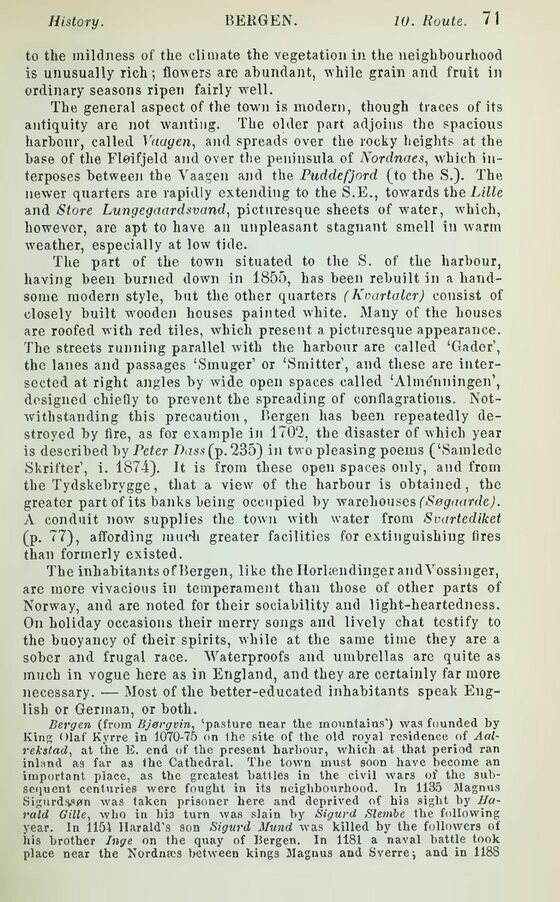
Full resolution (JPEG) - On this page / på denna sida - Norway - Pages ...

<< prev. page << föreg. sida << >> nästa sida >> next page >>
Below is the raw OCR text
from the above scanned image.
Do you see an error? Proofread the page now!
Här nedan syns maskintolkade texten från faksimilbilden ovan.
Ser du något fel? Korrekturläs sidan nu!
This page has never been proofread. / Denna sida har aldrig korrekturlästs.
to the mildness of the climate the vegetation in the neighbourhood
is unusually rich; flowers are abundant, while grain and fruit in
ordinary seasons ripen fairly well.
The general aspect of the town is modern, though traces of its
antiquity are not wanting. The older part adjoins the spacious
harbour, called Vaayen, and spreads over the rocky heights at the
base of the Fløifjeld and over the peninsula of Nordnaes, which
interposes between the Vaagen and the Puddefjord (to the S.). The
newer quarters are rapidly extending to the S.E., towards the Lille
and Store Lungegaardsvand, picturesque sheets of water, which,
however, are apt to have an unpleasant stagnant smell in warm
weather, especially at low tide.
The part of the town situated to the S. of the harbour,
having been burned down in 1855, has been rebuilt in a
handsome modern style, but the other quarters (Kvartaler) consist of
closely built wooden houses painted white. Many of the houses
are roofed with red tiles, which present a picturesque appearance.
The streets running parallel with the harbour are called ‘Gader’,
the lanes and passages ‘Smuger’ or ‘Smitter’, and these are
intersected at right angles by wide open spaces called ‘Almenningen’,
designed chiefly to prevent the spreading of conflagrations.
Notwithstanding this precaution, Bergen has been repeatedly
destroyed by Are, as for example in 1702, the disaster of which year
is described by Peter Dass (p. 235) in two pleasing poems (‘Samlede
Skrifter’, i. 1874). It is from these open spaces only, and from
the Tydskebrygge, that a view of the harbour is obtained, the
greater part of its banks being occupied by warehouses (Segaarde).
A conduit now supplies the town with water from Svartediket
(p. 77), affording much greater facilities for extinguishing fires
than formerly existed.
The inhabitants of Bergen, like the Horlændinger andVossinger,
are more vivacious in temperament than those of other parts of
Norway, and are noted for their sociability and light-heartedness.
On holiday occasions their merry songs and lively chat testify to
the buoyancy of their spirits, while at the same time they are a
sober and frugal race. Waterproofs and umbrellas are quite as
much in vogue here as in England, and they are certainly far more
necessary. — Most of the better-educated inhabitants speak
English or German, or both.
Bergen (from Bjørgvin, ‘pasture near the mountains’) was founded by
King Olaf Kyrre in 1070-75 on the site of the old royal residence of
Aal-rekslad, at the E. end of the present harbour, which at that period ran
inland as far as the Cathedral. The town must soon have become an
important place, as the greatest battles in the civil wars of the
subsequent centuries were fought in its neighbourhood. In 1135 Magnus
Sigurd.vøn was taken prisoner here and deprived of his sight by
Harald Gille, who in hi3 turn was slain by Sigurd Slembe the following
year. In 1154 Harald’s son Sigurd Mund was killed by the followers of
his brother Inge on the quay of Bergen. In 1181 a naval battle took
place near the Nordnrcs between kings Magnus and Sverre; and in 1188
<< prev. page << föreg. sida << >> nästa sida >> next page >>